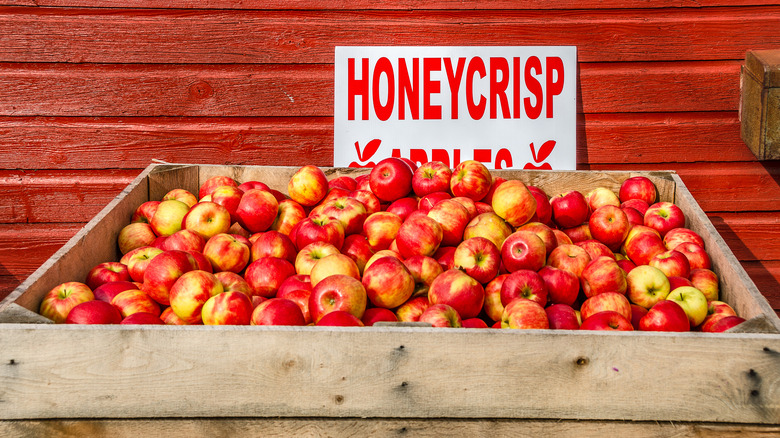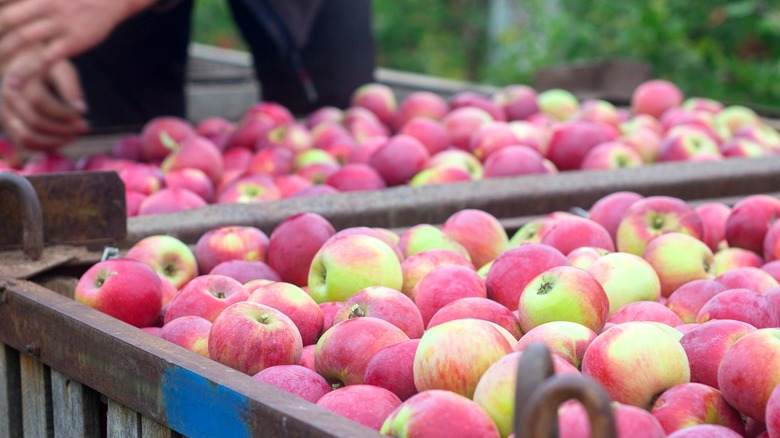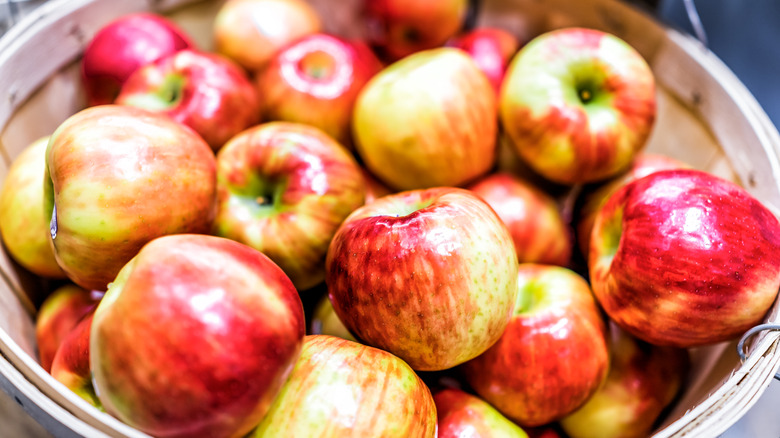Why Are Honeycrisp Apples So Expensive?
We may receive a commission on purchases made from links.
Apples, commonly associated with the forbidden fruit in ancient literature, have a great deal to teach people about economics. Take, for instance, the Honeycrisp apple. It routinely lands on the "most expensive" list of staple fruits sold at grocery stores and is one of the most popular apple varieties.
Unveiled by the University of Minnesota in 1991, Honeycrisp apples reached their highest price point in 2012. Some sold for as much as $1.81 per pound, according to the Fresh Fruit Portal. "Regular" apple prices, on the other hand, have historically landed somewhere between $0.45 and $0.79 per pound. So, why such a significant price difference? It really is all about economics: The demand for Honeycrisp apples outweighs their supply. The only other apple that seems to cost just as much, by percentage, anyway, is the Apple computer. As it turns out, apples are good business all around.
As for the Honeycrisp's popularity compared to other apples, there's a lot to like about it. It has the right mix of sour and sweet, kind of like the SweetTart candies, although the fruit is naturally much juicier and better for you. The Honeycrisp's crisp interior also makes for such a different eating experience than, say, that of the Red Delicious, which can be a bit grainy. However, the Red Delicious apple boasts a thick skin — something that the Honeycrisp lacks — which is more than an identifier of the bold red fruit. The thick skin has a benefit from a marketing standpoint: It hides dark spots and bruises in a way that the skin of the sweet-and-tart Honeycrisp can't.
Harvesting Honeycrisps is labor-intensive
If you're getting the impression that the Honeycrisp is more delicate than its redder, grittier cousin, you'd be right. A fragile, truly delicious apple takes more work to cultivate. Harvesting Red Delicious apples requires pickers to go through the orchard only once. All the apples come to full ripeness pretty much at the same time, making this part of the task a fairly easy and budget-friendly affair. Aside from this, workers two-hand the harvest, meaning that they pluck two apples from a tree at a time.
Not so simple with the Honeycrisp. Harvesters have to sweep the orchards up to five times before getting all the precious apples. When Honeycrisps are harvested, the picker must use one hand to pluck the fruit from the tree and the other hand to snip the stem. Because of its tender skin, it punctures easily, so the stem can't remain on the apple.
To add insult to injury, Honeycrisp growers typically see the apples on the tree every other year instead of annually, resulting in an unwelcome gap year between each season. Additionally, whereas most apples enjoy an 80% to 90% packout rate, Honeycrisp's packout rate is 65% at most, per The Minnesota Star Tribune. This statistic refers to the number of apples that make it to the market as fresh apples, as opposed to ones made into juice. About 35% of the harvested Honeycrisps are turned to apple juice, which requires several fruits per cup and retails for a drastically lower dollar amount than whole Honeycrisp apples.
The expiration of the apple's patent
For the University of Minnesota, the Honeycrisp apple proved to be a cash crop. The university previously held a patent on it, which expired in 2008. Before the patent ran out, though, the apple variety earned the college a pretty penny, around $17 million, making it the University of Minnesota's third-most-profitable product, per The Minnesota Star Tribune. Apple growers who wanted to produce the apple were required to cough up some dough, around $1.25 per tree in royalties, which the university still collects from farmers in several other countries.
Now that farmers don't have to pay for the apple-growing privilege, they're free to develop their own version of the Honeycrisp, potentially in sub-optimal conditions. For example, there has been an effort to grow Honeycrisps in Washington, the state where most apples come from in the U.S. However, the conditions in Washington don't match those of Minnesota. Many apples, including the Honeycrisp, thrive in colder weather — something that Minnesota has in abundance and Washington, for all its rain, lacks, at least when compared to the North Star State.
Having no preventative patent in place allows the apple to get to consumers a lot more cheaply, but it also means that the quality could suffer as a result. The beloved sweet-and-tart taste and crisp texture that made the Honeycrisp such a hot commodity could potentially become slightly faded memories of these standout features.


